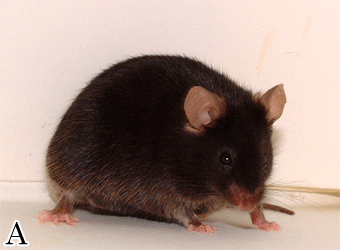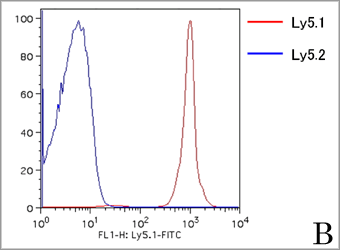C57BL/6-Ly5 Antigen (Ptprc) Congenic Strain
|
An useful cell marker system for hematopoietic cells in transplantation studies
The protein-tyrosine phosphatase, receptor type, C (Ptprc), also known as Ly5 or Cd45 gene of the mouse, encodes a set of transmembrane glycoprotein isoforms expressed only on hematopoietic cells [1, 2]. Ptprc was found to express in multiple forms by alternative splicing of different exons [3], and in allelic forms designated as Ly5.1/Cd45.1 of SJL/J and Ly5.2/Cd45.2/ of C57BL/6J [4, 5]. A Congenic strain, B6.SJL-Ptprca/Boy has been generated by backcrossing SJL/J carrying Ptprca (Ly5a/Cd45a, Ly5.1/Cd45.1) to the C57BL/6 background strain for hematological studies [6]. RIKEN BRC distributes B6.SJL-Ptprca/BoyYuoRbrc (C57BL/6-Ly5a, C57BL/6-Ly5.1, RBRC00126) mice (Fig. 1) as a useful cell marker system in bone marrow transplantation studies. The specific mouse monoclonal antibodies for the Cd45.1 and Cd45.2 have been exploited [4] and widely used to distinguish hematopoitetic cells of donor and recipient mice. A typical transplantation experiment is shown in Fig. 2.
The protein-tyrosine phosphatase, receptor type, C (Ptprc), also known as Ly5 or Cd45 gene of the mouse, encodes a set of transmembrane glycoprotein isoforms expressed only on hematopoietic cells [1, 2]. Ptprc was found to express in multiple forms by alternative splicing of different exons [3], and in allelic forms designated as Ly5.1/Cd45.1 of SJL/J and Ly5.2/Cd45.2/ of C57BL/6J [4, 5]. A Congenic strain, B6.SJL-Ptprca/Boy has been generated by backcrossing SJL/J carrying Ptprca (Ly5a/Cd45a, Ly5.1/Cd45.1) to the C57BL/6 background strain for hematological studies [6]. RIKEN BRC distributes B6.SJL-Ptprca/BoyYuoRbrc (C57BL/6-Ly5a, C57BL/6-Ly5.1, RBRC00126) mice (Fig. 1) as a useful cell marker system in bone marrow transplantation studies. The specific mouse monoclonal antibodies for the Cd45.1 and Cd45.2 have been exploited [4] and widely used to distinguish hematopoitetic cells of donor and recipient mice. A typical transplantation experiment is shown in Fig. 2.
Confusing Ly5 gene nomenclature and its history
Revision of gene and allele names for Ptprc (Ly5/Cd45) have led to much confusion regarding antigen specificity and allelic symbols [7]. Present and past nomenclature of Ly5 gene is summarized in Table 1.
Komura, et al. (1975), described an antigen expressed on T cells, and designated the specificity on C57BL/6 cells as Ly5.1 and on SJL cells as Ly5.2 [1]. According to gene naming convention for alleles, the C57BL/6 allele became Ly5a and SJL/J allele became Ly5b.
In 1987, Morse et al. proposed a revision of nomenclature of mouse lymphocyte antigens, which led to a reversed designation [8]. Consequently, the B6 allele became Ly5b (antigen specificity Ly5.2) and the SJL allele became Ly5a (antigen specificity Ly5.1).
A further revision was made on the cell surface antigens by Morse in 1992, where Ly5 became Cd45[9].
Finally, the gene name was changed to Ptprc in 1993, based on the work by Charbonneau et al. who demonstrated homology between a tyrosine phosphatase and CD45 protein [2]. This led to the present nomenclature of the B6 as Ptprcb and the SJL as Ptprca.
Revision of gene and allele names for Ptprc (Ly5/Cd45) have led to much confusion regarding antigen specificity and allelic symbols [7]. Present and past nomenclature of Ly5 gene is summarized in Table 1.
Komura, et al. (1975), described an antigen expressed on T cells, and designated the specificity on C57BL/6 cells as Ly5.1 and on SJL cells as Ly5.2 [1]. According to gene naming convention for alleles, the C57BL/6 allele became Ly5a and SJL/J allele became Ly5b.
In 1987, Morse et al. proposed a revision of nomenclature of mouse lymphocyte antigens, which led to a reversed designation [8]. Consequently, the B6 allele became Ly5b (antigen specificity Ly5.2) and the SJL allele became Ly5a (antigen specificity Ly5.1).
A further revision was made on the cell surface antigens by Morse in 1992, where Ly5 became Cd45[9].
Finally, the gene name was changed to Ptprc in 1993, based on the work by Charbonneau et al. who demonstrated homology between a tyrosine phosphatase and CD45 protein [2]. This led to the present nomenclature of the B6 as Ptprcb and the SJL as Ptprca.

| Depositor | : | Dr. Toshitada Takahashi, Aichi Cancer Center Research Institute | |
| References | : | 1. | Komura K, Itakura K, Boyse EA, John M. Ly-5: a new lymphocyte antigen system.Immunogenetics. 1975 1:452-456. |
| 2. | Charbonneau H, Tonks NK, Walsh KA, Fischer EH. The leukocyte common antigen (CD45): a putative receptor-linked protein tyrosine phosphatase. Proc Natl Acad Sci U S A.1988 Oct;85(19):7182-6. | ||
| 3. | Saga Y, Tung JS, Shen FW, and Boyse EA. Sequences of Ly-5 cDNA: isoform-related diversity of Ly-5 mRNA. PNAS USA. 1986 83: 6940-6944. | ||
| 4. | Shen FW, Tung JS, and Boyse EA. Further definition of the Ly-5 system.Immunogenetics. 1986 24: 146-149. | ||
| 5. | Tung JS, Scheid MP, Pierotti MA, Hammerling U, and Boyse EA. Structural features and selective expression of three Ly-5+ cell-surface molecules. Immunogenetics. 1981 14: 101-106. | ||
| 6. | Shen FW, Saga Y, Litman G, Freeman G, Tung JS, Cantor H, and Boyse EA. Cloning of Ly-5 cDNA. PNAS USA. 1985 82: 7360-7363. | ||
| 7. | Mobraaten LE. Ly5 gene nomenclature, C57BL/6J and SJL/J – A history of change.JAX Notes. 1994 458, 2. | ||
| 8. | Morse HC III, Shen FW, Hammerling U. Genetic nomenclature for loci controlling mouse lymphocyte antigens. Immunogenetics. 1987 25:71-78. | ||







